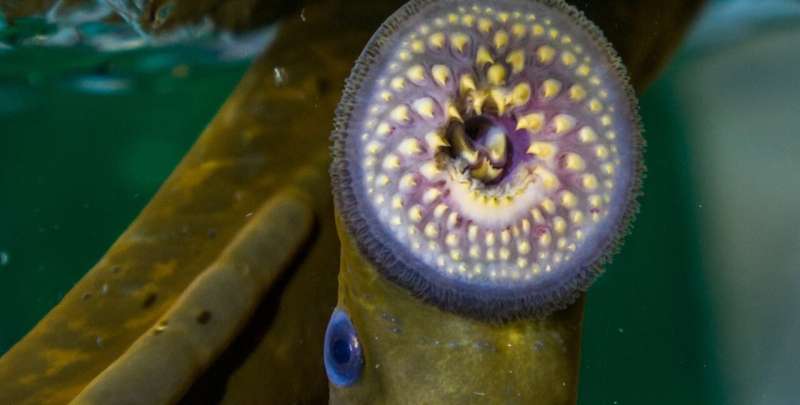Coming to a head: How vertebrates became predators by tweaking the neural crest

Lamprey are blood-sucking vampire-like fish that attach to and eventually kill game fish, making them the bane of many a fisherman's existence. Like something out of a horror film, these parasites use radial rows of sharp teeth to dig into the skin of their host and extract blood and other fluids for food. But to Caltech scientists, these gruesome pests hold important clues to the evolution and success of vertebrates.
The eel-like fish do not have a jaw, but because lamprey are the most primitive animals with a backbone (vertebrates) on Earth, comparing them to more recently evolved vertebrates could offer insight into how the jaw and other structures of the head evolved over time. This has important implications for understanding behaviors such as predation that rely heavily on the power of the jaw.
Caltech scientists have discovered that a population of embryonic stem cells called neural crest cells may help explain how vertebrates progressively evolved a more and more efficient head. Neural crest cells originate within the developing central nervous system before migrating throughout the embryo. They are a major player in the development of the jaws and other important components of the head and face, making them a good candidate for a role in vertebrate head evolution.
The research was conducted in the laboratory of Marianne Bronner, Albert Billings Ruddock Professor of Biology and director of the Beckman Institute. A paper describing work appeared in the journal Nature on October 31.
"Lamprey are like living fossils, and we use them to guess what primitive vertebrates might have looked like," says Bronner. "In the 1980s, it was proposed that the neural crest was a vertebrate invention that enabled acquisition of a 'new head.' We wanted to test this by looking at neural crest genes in lamprey."
The study, led by postdoctoral scholar Megan Martik, began by comparing the genetic makeup of lamprey neural crest with that of chicken embryos. The team discovered that the lamprey neural crest cells lacked important genes that are present in the head neural crest of birds and mammals, and critical for making advanced structures like the jaw.
The team wondered how the neural crest ultimately acquired the genes. To look for clues, they examined the neural crest genes of animals that have jaws, such as sharks and zebrafish, and evolved after lamprey but well before chickens and other birds. Martik and her colleagues found that the genetic program that helped to make the head more sophisticated was created by the progressive addition of genes to the neural crest repertoire as the vertebrate tree of life advanced and new species evolved.
The paper describing the research is titled "Evolution of the new head by gradual acquisition of neural crest regulatory circuits."
More information: Megan L. Martik et al. Evolution of the new head by gradual acquisition of neural crest regulatory circuits, Nature (2019). DOI: 10.1038/s41586-019-1691-4
Journal information: Nature
Provided by California Institute of Technology




















